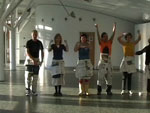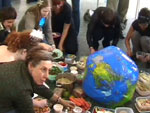Creative Resistances
17–18 September 2005
Thirty relative strangers stand in a circle in the middle of a barren roundabout under the Bow flyover. Cars and concrete surround them on every side. They are playing with a huge inflatable globe, throwing it high into the suffocating air, trying to keep it from touching the ground. So began the Creative Resistance workshop, two days of exercises, debate, games and presentations that explored the spaces in between art and activism, direct action and live art.
Following a treasure hunt - that took participants through a potted history of a few local acts of creative resistance, ranging from the match girl strikers cutting themselves in front of the Gladstone statue, to Sylvia Pankhurst giving up art to apply herself to militant suffragette actions from her base in Bow Road - the workshop settled itself in the beautiful waterside arts pavilion in Mile End Park.
A wonderful diversity of artists and activists came together in a warm and convivial atmosphere to explore numerous themes and methodologies of creative resistance. Debates and exercises on what makes an act of creative resistance both beautiful and politically effective were followed by workshops to develop tools for collective working methods (developed from anarchist movements). A moving and honest sharing of individual passions, projects and inspirations took place during an exercise, which mixed a long game of hug tag (from the arsenal of rebel clowning games) with a technique to show various affinities within the group. Tea, popcorn and cake was served during presentations by John Jordan and artists activists The Vacuum Cleaner and a final exercise involving £200 cash as material for actions led to heated debates on the role of money, commodities and capitalism in developing resistance strategies. The enthusiasm and radical engagement of participants was powerful and participants are now setting up an e-list (on riseup.net [new window]) and hope to meet again soon to continue to develop some of the ideas and methodologies that emerged during the workshop.




